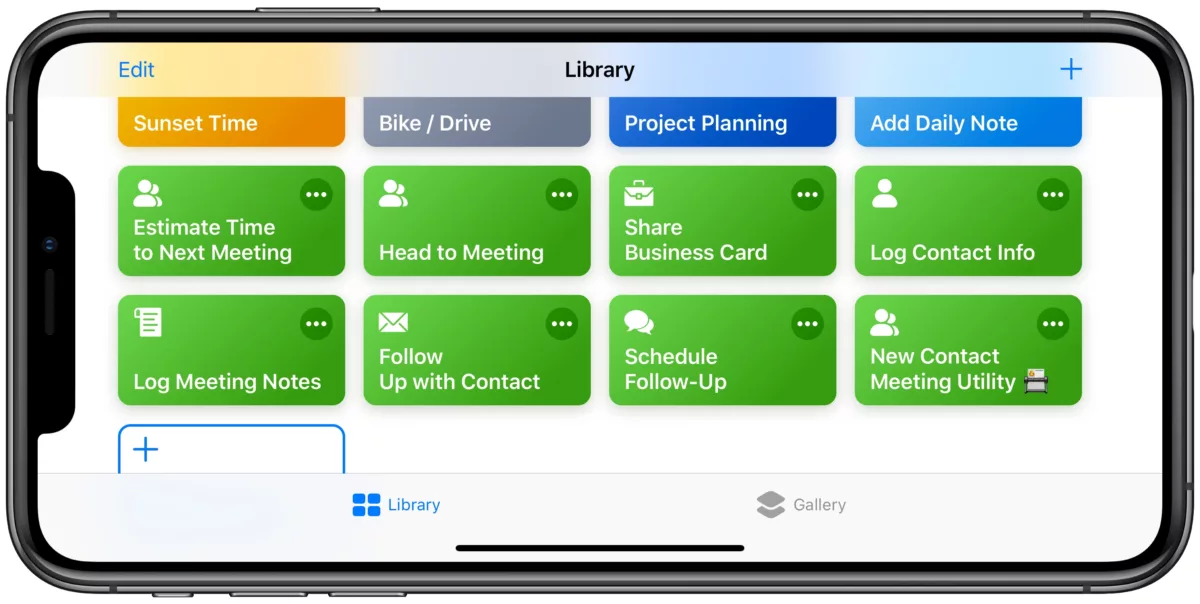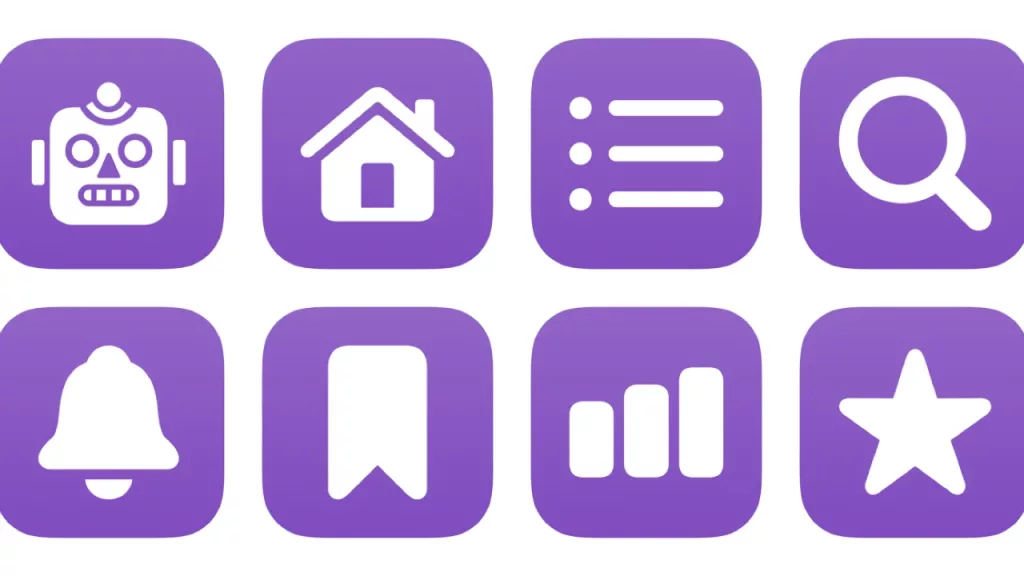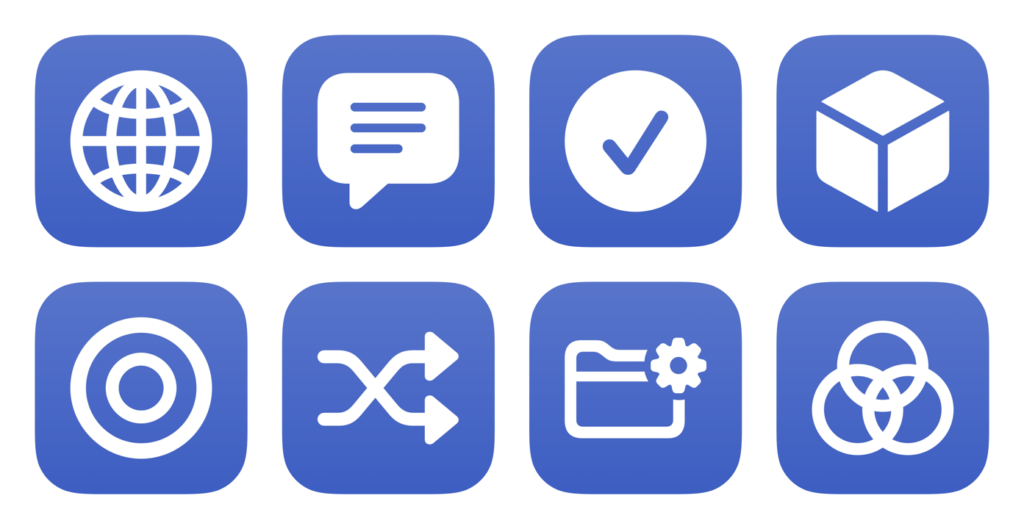After a meeting with someone new yesterday, I realized there was a few places where I could have used the Shortcuts app to speed up the processes around our encounter.
Before the meeting, I was headed somewhere new and needed to figure out how to get there on time.
During the meeting, I was fumbling with my phone a bit, handing it to them to type in their contact information, and didn’t have an easy way to share mine either. Plus, I dealt with everything after the meeting too – writing down notes, sharing my info, and following up later.
From all this, I noticed a few repeating patterns, that could be automated using mostly default apps – the data I need already exists or can be entered on the fly.
So, I came up with a few jobs to be done:
- Knowing when to leave to get to the meeting on time
- Getting directions to the meeting when it’s time to leave
- Sharing your “business card” contact information
- Logging someone else’s contact information
- Taking helpful meeting notes afterwards
- Following up with them the same day (or later)
- Scheduling that follow up if it’s not today
The Shortcuts app already has access to your Calendar events, Reminders, Maps, and Travel Time.
Plus, using the Scripting actions, you can structure a series of prompts for yourself to follow and enter information as the shortcut is running – perfect for this in-the-moment type of situation.

Naturally, I got to work building custom shortcuts in the Shortcuts app for each of these – here’s what I came up with:
- Estimate Time to Next Meeting:
This looks at your upcoming calendar events, gets just the first one, and estimates travel time from the current location. Then, it subtracts the travel time from when the event starts, using Show Result to read out the event info, how long it’ll take to get there, and when you should leave.Works great when added to Siri, and run from Apple Watch, AirPods, or HomePod. Get the shortcut here.
- Head to Meeting:
This looks at that same upcoming calendar event, then passes the information into the maps app of your choice to get driving directions there.Feel free to change the Mode to your preferred option, or add a new menu item for a different app like Baidu Maps. Get the shortcut here.
- Share Business Card:
This requires you to set a separate contact card with only your business information; once you’ve done that and added it, you can then run this shortcut at any time and choose how to share it. I’ve added options to AirDrop it or Share it using the system share sheet (if you wanted to send it via Messages or something else).Works great when placed in the Shortcuts widget. Get the shortcut here.
- Log Contact Info:
This shortcut manually creates a VCard for a new contact, asking you to enter information through a series of prompts. Then, using scripting tools and logic, the shortcut places it properly in a Text field according to the VCard standard, then uses Set Name to coerce that text into a .vcard file (just like using Rename on macOS lets you change a file extension to change the file type). Finally, it uses the Open In action to share it to Contacts, where you can confirm it as a new contact. - Log Meeting Notes: This shortcut lets you pick from recently-created contacts, then asks a series of prompts for capturing notes about your meeting with them. This includes where you met, what you talked about, how it went (your reaction to the success of the meeting), action items that will be numbered for you, and anything notable to remember for later. Then, it formats all that information into Markdown and passes it into my “Logs” journal in Day One, tagged with “Meeting” and “Notes”.
- Follow Up with Contact:
This shortcut lets you pick from recently-created contacts, then lets you choose how to follow up with them – you can use Messages, email, call them on the phone, use FaceTime audio or video, connect via Skype, or send them a WhatsApp message. For sake of speed, messages, email, and WhatsApp are also set up using Dictation, with a casual message or more formal email message – the email even uses a relative date like “Meeting from 4 days ago”.Works well in the widget to reach out to a recent contact in their preferred method without you tapping through to each individual app. Get the shortcut here.
- Schedule Follow-Up:
This shortcut asks you to pick which contact you want to follow-up with, then asks for a specific date and time for when you want to be reminded to follow up with them. It also includes a suggested date based on an adjustment from the current date – I’ve set the default to 3 days, but this could be swapped to weeks or months depending on your typical needs.Works great in the Shortcuts widget. Get the shortcut here.
Plus, just to be fancy, I combined these shortcuts into one master shortcut that includes the action steps from all 7 options underneath a Choose From Menu action.
- New Contact Meeting Utility:
This lets you pick what you want to first, then proceeds as if you were running each of these shortcuts.

If you want all the functionality in one go, get the shortcut here.
These 7, er, 8 shortcuts were fun to build, useful to almost any working professional, and taught me a few things along the way.
If you have any other ideas on business-related shortcuts, feel free to reach out to me on Twitter. Otherwise, check out each of the shortcuts below and examine how they work – there’s tons of different techniques in here, so it’s worth a look at how I built these.
Get all the shortcuts:
- Estimate Time to Next Meeting
- Head to Meeting
- Share Business Card
- Log Contact Info
- Log Meeting Notes
- Follow Up with Contact
- Schedule Follow-Up
- New Contact Meeting Utility ?
- I would have sent this to Notes, but the action doesn’t accept Plain Text.If you wanted to use Notes, you could use the Make Rich Text From Markdown action, Copy to Clipboard, and then Create Note & Show Note, then paste it in, but that’s not as automated as I’d like.Otherwise, this can work with any Markdown application – try the native actions for Bear. ↩




